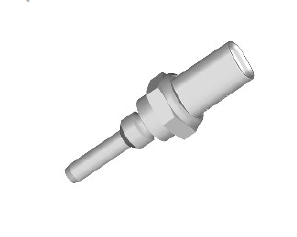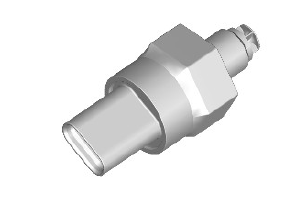Land Rover Discovery: Crankshaft Position (CKP) Sensor
.jpg)
The CKP sensor is located at the front left side of the engine. The sensor is located in a hole in the lower timing chain cover and is secured with a screw.
The sensor receives a 5V reference voltage from the ECM. Two further connections to the ECM provide ground and signal output.
The CKP sensor is positioned adjacent to the reluctor ring, which is an integral part of the drive plate on vehicles with automatic transmission and the dual mass flywheel on vehicles with manual transmission. The reluctor ring has 58 teeth and a section where 2 teeth are missing. The sensor is a Hall-Effect sensor which uses the missing teeth on the trigger wheel to determine the crankshaft position and rotational speed.
The CKP sensor is a Hall-Effect sensor which produces a square wave signal, the frequency of which is proportional to engine speed. The sensor measures the magnetic field variation induced by the reluctor ring.
If a fault occurs with the CKP sensor, a Diagnostic Trouble Code (DTC) is registered in the ECM. The engine will continue to operate using data from the Camshaft Position (CMP) sensor until the fault has been corrected.
The ECM uses the signal from the CKP sensor for the following functions:
- Synchronization
- Determine fuel injection timing
- Produce an engine speed signal which is broadcast on the HS-CAN powertrain systems bus for use by other systems.
CAMSHAFT POSITION (CMP) SENSOR
.jpg)
The CMP sensor is located in a hole in the camshaft carrier and is secured with a screw. The sensor tip protrudes through camshaft carrier to pick up on a reluctor ring on the exhaust camshaft. The CMP sensor is a Hall-Effect sensor which produces a square wave signal, the frequency of which is proportional to engine speed. The sensor measures the magnetic field variation induced by the reluctor ring.
The CMP sensor receives a 5V reference voltage from the ECM. Two further connections to the ECM provide ground and signal output. The ECM uses the signal from the CMP sensor and the CKP sensor to determine current exhaust camshaft position and camshaft adjustment.
If a fault occurs with the CMP sensor, a DTC is registered in the ECM. Two types of failure can occur; camshaft signal frequency too high or total failure of the camshaft signal. The DTC recorded by the ECM can also relate to a total failure of the crankshaft signal or crankshaft signal dynamically implausible. Both components should be checked to determine the cause of the fault.
If a fault occurs with the CMP sensor when the engine is running, the engine will continue to run. Once the engine is switched off, the engine will crank and restart while the fault is present, but Variable Camshaft Timing (VCT) control will be disabled.
MASS AIR FLOW AND TEMPERATURE (MAFT) SENSOR
.jpg)
The MAFT sensor is located on the top cover of the air filter housing and is secured with two screws. The sensor is downstream of the air filter and measures the air entering the clean air duct to the turbocharger.
The MAFT sensor receives a 12V power supply from the ECM relay in the Engine Junction Box (EJB). Three further connections provide signal feedback to the ECM for intake air volume and temperature.
The MAFT sensor works on the hot film principle. Two sensing elements are contained within a film. One element is maintained at ambient (air intake) temperature, for example 25 ºC (77 ºF). The other element is heated to 200 ºC (392 ºF) above the ambient temperature, for example 225 ºC (437 ºF).
Intake air entering the engine passes through the MAFT sensor and has a cooling effect on the film. The ECM monitors the current required to maintain the 200 ºC (392 ºF) differential between the two elements and uses the differential to provide a precise, non-linear, frequency based signal which equates to the volume of air being drawn into the engine.
The ECM checks the calculated air mass against the engine speed. If the calculated air mass is not plausible, the ECM uses a default air mass figure which is derived from the average engine speed compared to a stored characteristic map. The air mass value will be corrected using values for boost pressure, atmospheric pressure and air temperature.
The MAFT sensor incorporates a Negative Temperature Coefficient (NTC) thermistor in a voltage divider circuit. The NTC thermistor works on the principle of decreasing resistance in the sensor as the temperature of the intake air increases. As the thermistor allows more current to pass to ground, the voltage sensed by the ECM decreases. The change in voltage is proportional to the temperature change of the intake air. Using the voltage output from the MAFT sensor, the ECM can correct the fueling map for intake air temperature. The correction is an important requirement because hot air contains less oxygen than cold air for any given volume.
The MAFT sensor output is a digital signal proportional to the mass of the incoming air. The ECM uses this data, in conjunction with signals from other sensors and information from stored fueling maps, to determine the precise fuel quantity to be injected into the cylinders. The signal is also used as a feedback signal for the Exhaust Gas Recirculation (EGR) system.
If the MAFT sensor fails the ECM implements the default strategy based on engine speed. In the event of a MAFT sensor signal failure, any of the following symptoms may be observed:
- Difficult starting
- Engine stalls after starting
- Delayed engine response
- Emission control inoperative
- Idle speed control inoperative
- Reduced engine performance.
MANIFOLD ABSOLUTE PRESSURE AND TEMPERATURE (MAPT) SENSOR
.jpg)
A single MAPT sensor is located in the intake manifold after the electric throttle. The sensor provides a voltage signal to the ECM relative to the intake manifold pressure and temperature.
The MAPT sensor has a 4 pin connector which is connected to the ECM and provides a 5V reference voltage from the ECM, a pressure and a temperature signal input to the ECM and a ground connection.
The MAPT sensor uses a diaphragm transducer to measure the air pressure.
The ECM uses the MAPT sensor signal for the following functions:
- Maintain manifold boost pressure
- Reduce exhaust smoke emissions when driving at high altitude
- Control of the EGR system.
If the MAPT sensor fails, the ECM uses a default pressure of 1013 mbar (14 lbf/in²). In the event of a MAPT sensor failure, the following symptoms may be observed:
- Altitude compensation inoperative (black smoke emitted from the exhaust)
- Active boost control inoperative.
CYLINDER HEAD TEMPERATURE SENSOR
.jpg)
The cylinder head temperature sensor is located in a threaded boss in the front of the cylinder head, adjacent to the oil filter housing and the cylinder head water outlet pipe.
The sensor is a NTC sensor with a two pin connection; one pin receives a 5V reference voltage from the ECM and the second pin provides a signal feedback to the ECM.
CYLINDER BLOCK TEMPERATURE SENSOR

The cylinder block temperature sensor is located in a threaded boss on the front of the cylinder block, between the electric thermostat housing and the High Pressure (HP) fuel pump.
The sensor is a NTC sensor with a two pin connection; one pin receives a 5V reference voltage from the ECM and the second pin provides a signal feedback to the ECM.
OIL PRESSURE AND TEMPERATURE SENSOR

The oil pressure and temperature sensor is located in a threaded port in the oil filter and housing assembly.
The oil pressure and temperature sensor has a three pin connector and it is connected directly to the ECM. One pin supplies a 5V reference voltage from the ECM, the second pin is ground reference.
The third pin is a multiplexed combined Pulse Width Modulation (PWM) output, which provides the following signals to the ECM:
- Oil pressure
- Oil temperature
- Sensor diagnostic
The oil pressure value is used internally with the ECM. The ECM compares oil pressure value to a predetermined threshold for pressure and generates a specific driver message setting for communication to other modules. This message then transmitted via the HS-CAN powertrain systems bus to the Instrument Cluster (IC), which displays an 'Engine oil level critically low' message on the message center.
Low Pressure (LP) EGR Cooler Outlet Temperature Sensor
.jpg)
Vehicles have a Low Pressure (LP) EGR cooler outlet temperature sensor located to the LP EGR valve. The sensor receives a reference voltage from the ECM and returns a signal relative to the exhaust gas output from the LP EGR cooler.
CHARGE AIR COOLER TEMPERATURE SENSOR
.jpg)
The charge air cooler temperature sensor is located in the outlet of the charge air cooler. The sensor is a quick fit component which is pushed into the charge air cooler port and rotated through 90 degrees to lock. An Oring seal fitted to the charge air cooler temperature sensor prevents leakage.
The temperature sensor is an NTC type sensor which receives a 5V reference voltage from the ECM and returns a signal proportional to the intake air temperature.

